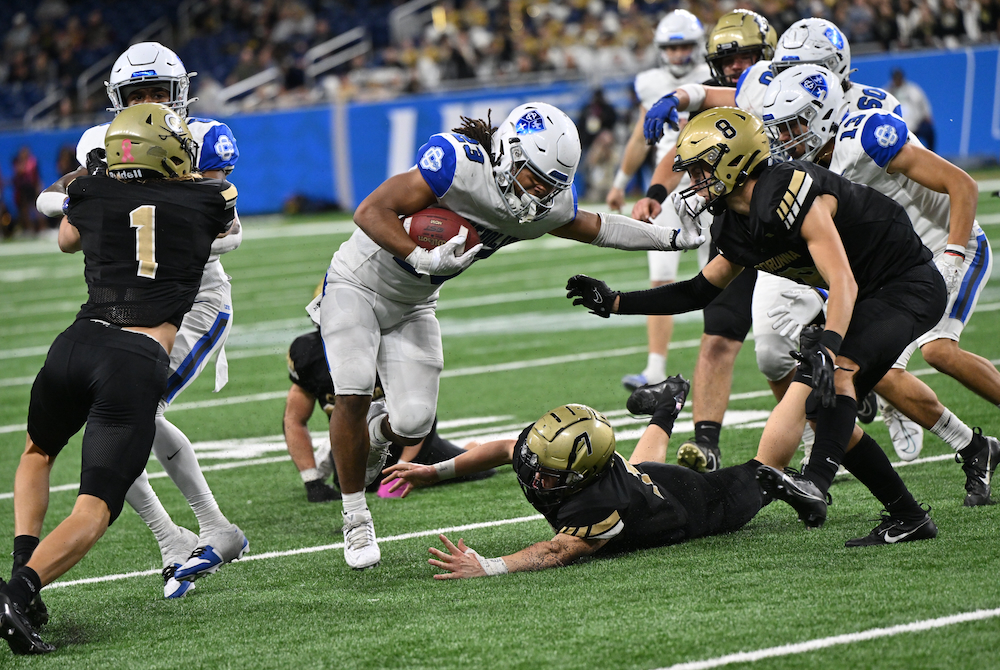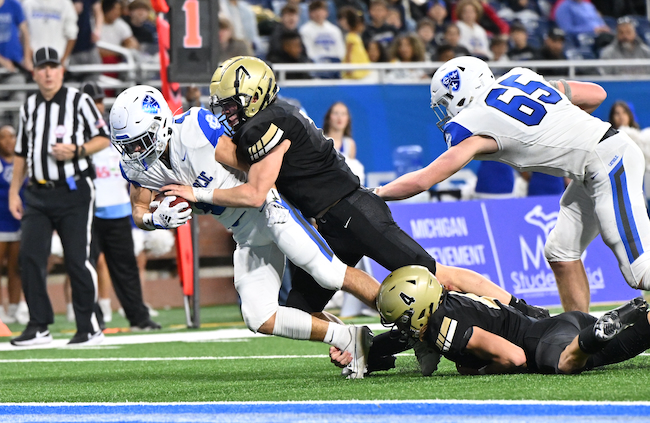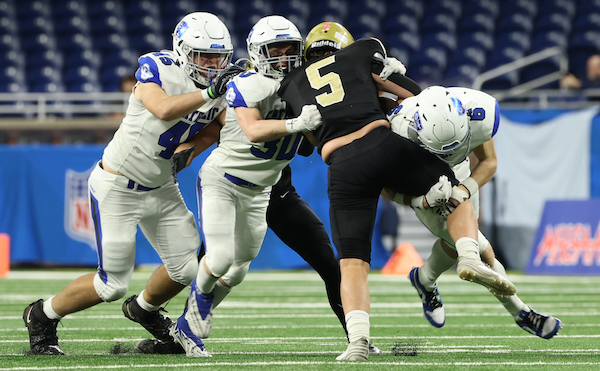
Haslett Saving Big Hits for Game Time
August 16, 2016
By Geoff Kimmerly
Second Half editor
HASLETT – The sound of cleats on pavement. He and his teammates, hand in hand, walking toward the field together minutes before kickoff. Manowar’s “Heart of Steel” ringing in their ears from a few minutes before.
 Justin Kuchnicki gave himself goose bumps Monday describing Haslett’s weekly pregame ritual, which the senior lineman will take part in again beginning Aug. 26 when the Vikings open this season against Remus Chippewa Hills.
Justin Kuchnicki gave himself goose bumps Monday describing Haslett’s weekly pregame ritual, which the senior lineman will take part in again beginning Aug. 26 when the Vikings open this season against Remus Chippewa Hills.
They’ll certainly be revved up – and especially to lay some big hits after saving them up during three weeks of non-collision practices.
Haslett has one of the most successful football programs in the Lansing area, with two trips to MHSAA championship games and 14 playoff appearances total over the last 18 seasons. The Vikings finished 6-4 a year ago against a schedule featuring four eventual playoff teams.
The program also might be the first in all of Michigan high school football to fully eliminate full-speed hitting at practice, something Haslett has moved toward over the last few seasons before longtime coach Charlie Otlewski decided to knock it out of his practice plans completely this fall in large part to keep his players healthier for when it matters most.
“It gives you the edge when it gets to game day. You practice all week and you’re not really hitting or doing anything like that, and you get to game day … and everyone’s ready to just go out there and fly around and make plays,” Kuchnicki said. “You’re not really worried about kinks and stuff in your body that you’d have from practices, so you just go out there and lay it on the line.”
Friday was the first day Michigan high school players were allowed to practice in full pads. Storms drenched mid-Michigan that afternoon, so Haslett’s first day in full gear was Monday. And from a distance, it sounded like any other full-contact practice with the normal hoots and hollers and smacking of pads.
But on closer look, it was anything but. Lineman worked against blocking dummies on a sled or teammates holding hand pads. When the offense came together to run plays, linemen blocked against overturned plastic trash barrels. On the opposite end of the field, subvarsity players worked on defensive pursuit angles but again without hitting. Under a set of uprights laid an old gymnastics mat used to soften the fall during tackling drills, which players again did against standup dummies instead of their teammates.
Reducing collisions – that is, live, game-speed, player-vs.-player hitting – remains the focus of most conversations on health and safety in football. Much of the discussion is centered on reducing concussions, and MHSAA rules changes that took effect beginning with the 2014 season limit teams to one practice per day during the preseason (when teams frequently practice twice) where collisions can take place. During the regular season, teams can have collisions during practice only two days per week.
 Otlewski – who formerly coached St. Ignace from 1990-93 before taking over at Haslett in 1994 – said his practices used to follow what could be considered a traditional after-school plan: individual position drills for an hour or more followed by 11-on-11 full contact team practice for 30-40 minutes, twice a week.
Otlewski – who formerly coached St. Ignace from 1990-93 before taking over at Haslett in 1994 – said his practices used to follow what could be considered a traditional after-school plan: individual position drills for an hour or more followed by 11-on-11 full contact team practice for 30-40 minutes, twice a week.
But a handful of reasons, chiefly the desire to avoid injuries, started his program on a different path five years ago.
“Nobody wants injuries, but you surely don’t want them in practice. Then the concussion thing started to happen. (But) we didn’t do it because of concussions; we did it because of general overall injuries,” Otlewski said.
“If we lose a guy in Thursday’s scrimmage, or next Thursday in a game, OK, that’s football. But what we don’t want to do is lose someone in practice, because that seems unnecessary.”
The initial changes Haslett began to make to practices that fall of 2011 became drastic two years later, when he and his staff went to a different practice model completely. The Vikings now break every practice into 10-minute sessions alternating between team time and position drills, so position coaches can work with players individually before and after seeing how they perform when all 11 are running plays together.
This new breakdown brought the amount of player-on-player contact at practice down significantly as much more time was dedicated to learning proper footwork, blocking and tackling techniques and other fundamentals. Players on Monday worked at 50-percent speed, at most, against teammates either in front of them and also not moving at game speed, or against others holding pads and dummies.
The last two seasons, the only full-contact session during practices came during preparation for goalline situations; Otlewski and his staff decided to eliminate those this fall as well.
“We’re OK with a certain level (of contact). But we never want to go on the ground; we always want to stay up,” he said. “We want to go fast enough so where we have to use the perfect technique to get there footwork-wise. But we’re trying to eliminate the physicality part.”
To be clear, eliminating all collisions/contact is not required by the MHSAA. And there are probably more than a few in the coaching fraternity who would think Haslett is making a massive mistake.
But the Vikings’ no-contact strategy follows a way of thinking made popular in part by coaches like Dartmouth College’s Buddy Teevens, whose team hasn’t tackled during practices in six years. The Ivy League as a whole adopted a policy of no tackling in practice for the regular season beginning this fall.
 Otlewski said teaching to tackle without contact allows his players to practice the same technique-building drills during four-player offseason workouts, his team’s no-pads summer camp and then while wearing pads during the season. His defense doesn’t face a live offense during the week, but he doesn’t think his players lose out because they can gain just as much from watching film and working on pursuit angles and recognizing formations. Same goes for his offense, which can still practice skill work and the passing game full-speed while lineman go half-speed working on footwork and blocking technique.
Otlewski said teaching to tackle without contact allows his players to practice the same technique-building drills during four-player offseason workouts, his team’s no-pads summer camp and then while wearing pads during the season. His defense doesn’t face a live offense during the week, but he doesn’t think his players lose out because they can gain just as much from watching film and working on pursuit angles and recognizing formations. Same goes for his offense, which can still practice skill work and the passing game full-speed while lineman go half-speed working on footwork and blocking technique.
And he sees 37 players on his varsity roster, with that total remaining consistent over the last many seasons – while three opponents on this year’s schedule don’t have junior varsities and a fourth won’t field a freshman team.
His players three seasons ago didn’t really like the idea of not hitting in practice at first. But they’ve since bought in. He hasn’t heard a ton from parents either way; but he taught a class on football for local moms over the winter, and they seemed to like the idea as well.
“On one hand, I’m a little apprehensive,” Otlewski said. “OK, we haven’t gone full go. Is there a difference all of a sudden when it’s live Thursday against (Grand Rapids) Christian? Are we going to be up to speed?
“I think I still worry about that a little bit. But once we get into it, it’s fine.”
Kuchnicki is just as confident. Contact doesn’t bother this guy. He’s 6-foot-6 and in the neighborhood of 320 pounds. Sure, he’d love to have one contact practice this year so he and his teammates can back up some of the trash-talking they do to each other on the field.
But he’s fine with saving his biggest hits for opponents – and especially those who might think Haslett won’t be prepared for a physical game.
“They’d probably think we’re soft,” Kuchnicki said. “But when it comes game day, they change their minds instantly. I’ll tell you that.”
 Geoff Kimmerly joined the MHSAA as its Media & Content Coordinator in Sept. 2011 after 12 years as Prep Sports Editor of the Lansing State Journal. He has served as Editor of Second Half since its creation in Jan. 2012. Contact him at [email protected] with story ideas for the Barry, Eaton, Ingham, Livingston, Ionia, Clinton, Shiawassee, Gratiot, Isabella, Clare and Montcalm counties.
Geoff Kimmerly joined the MHSAA as its Media & Content Coordinator in Sept. 2011 after 12 years as Prep Sports Editor of the Lansing State Journal. He has served as Editor of Second Half since its creation in Jan. 2012. Contact him at [email protected] with story ideas for the Barry, Eaton, Ingham, Livingston, Ionia, Clinton, Shiawassee, Gratiot, Isabella, Clare and Montcalm counties.
PHOTOS: (Top) Haslett lineman work on blocking during Monday's practice. (Middle) Vikings coach Charlie Otlewski instructs his players on one of the team's blocking schemes. (Below) Backs work on the option with barrels serving as the defensive front.

Driven by 2022 Semifinal Loss, GR Catholic Central Reclaims Top Spot in D5
By
Tom Kendra
Special for MHSAA.com
November 26, 2023
DETROIT – Corunna coach Steve Herrick’s final words at the postgame press conference pretty much summed up his team’s struggles in Sunday’s Division 5 title game.
“It’s tough to prepare for a team like Grand Rapids Catholic Central,” explained Herrick, whose school was playing at the Finals for the first time.
“We took care of preparing for their receivers and linemen pretty well, but No. 7 and No. 23 were hard for us to mimic at practice. We don’t have anyone like them.”
With that, Herrick and his players exited the interview area just as GRCC’s No. 7, senior quarterback Connor Wolf, and No. 23, senior running back Kellen Russell-Dixon, squeezed past them, the stars of the Cougars’ 21-7 victory.
Wolf scored all three touchdowns for GRCC, on a pair of 1-yard runs in the second quarter and a 10-yard burst in the fourth quarter, as the Cougars won their eighth Finals title in 10 championship game appearances.
Russell-Dixon didn’t get in the end zone, but was the game’s leading rusher with 20 carries for 133 yards, to go with two receptions for 19 yards.
Both senior leaders said it was a devastating loss to eventual champion Gladwin in last year’s Semifinal, 28-21, which fueled the team’s desire to get back to the mountaintop.
 “That loss last year showed us we still had so much work to do to be our best,” said Wolf, who completed 10-of-22 passes for 82 yards and rushed 11 times for 78 yards and the three scores.
“That loss last year showed us we still had so much work to do to be our best,” said Wolf, who completed 10-of-22 passes for 82 yards and rushed 11 times for 78 yards and the three scores.
Added Russell-Dixon: “I remember watching the Division 5 championship game on TV last year, and just thinking about how we had it in our hands and we weren’t focused and we let it slip away.”
GRCC, which finished 13-1 after a season-opening home loss to powerhouse Chicago Loyola, was focused and prepared Sunday, mixing up the pass and run exquisitely to take a 14-0 halftime lead.
Corunna, also 13-1, averaged more than 41 points per game coming in, but struggled in the first half against the experienced Cougars.
“I felt like they were more physical than us,” said Corunna senior quarterback and defensive back Wyatt Bower. “I felt like all year we didn’t get the respect we deserved, but we battled those guys in the second half.”
The Cavaliers did exactly what they had to do coming out of halftime, taking the third-quarter kickoff and marching 67 yards in 14 plays, capped with a 7-yard burst up the middle by Bower on a 4th-and-goal play, that cut the lead to 14-7.
That score brought a sizable group of black-and-gold clad fans from Corunna, a community of about 4,000 people between Lansing and Flint, to its feet.
However, that turned out to be as close as Corunna would get against a quick and hard-hitting GRCC defense.
The Cougars added an insurance touchdown in the fourth quarter after a short punt gave them the ball at Corunna’s 35-yard line. Eight plays later (six of those runs by Russell-Dixon), Wolf took it the final 10 yards to ice the win.
“It never gets old,” explained 12th-year GRCC coach Todd Kolster, who has guided the Cougars to titles in four of the past five years and six of the last eight. “One of the things I cherish the most from the Finals is the team photo we take down on the field. I never get in those photos. Then when I get a moment, I can look at all those kids who worked so hard and gave so much.”
 GRCC, which held a 315-239 edge in total yardage, made Corunna work for every yard Sunday.
GRCC, which held a 315-239 edge in total yardage, made Corunna work for every yard Sunday.
Senior linebacker Austin Baxter (6-foot, 185 pounds) set the tone for the Cougars’ defense with eight tackles. Adam Whalen and Derek Weiss made six tackles apiece, and Mill Coleman III added five tackles and the game-clinching interception in the end zone with five minutes remaining.
Wolf said family ties drive the Cougars’ year-in, year-out success – the connections to both his football brothers and his actual biological family.
“My dad, grandparents, uncles, they all went to Catholic Central,” said Wolf, a 6-3 dual threat QB who passed for more than 2,500 yards with 23 TD passes and only two interceptions. “This means a lot to all of us, to continue the Cougar tradition.”
Corunna, which was led all season by Wyatt Bower and his identical twin brother, Tarick (one of his favorite receiving targets), got a strong final game from senior fullback/linebacker Jaden Edington, who made a game-high 10 tackles and rushed 14 times for 70 yards.
The Bower twins, sprinters who helped Corunna win the Lower Peninsula Division 2 Track & Field championship last spring, finished their football careers in style. Wyatt completed 6-of-16 passes for 123 yards, no touchdowns and one interception, while making eight tackles on defense. Tarick made two catches for 69 yards.
Kaden Cowdrey and Dayne Zeeman each made eight tackles for the Cavaliers.
PHOTOS (Top) Grand Rapids Catholic Central’s Kellen Russell-Dixon (23) prepares for contact with Corunna’s Kaden Cowdrey (8) during Sunday’s Division 5 Final. (Middle) The Cavaliers’ Wyatt Bower (4) and Dayne Zeeman work to bring down GRCC’s Lucas Thelen short of the goal line. (Below) Brayden Sweeney (6) and Derek Weiss (30) wrap up Corunna’s Parker Isham. (Photos by Hockey Weekly Action Photos.)

